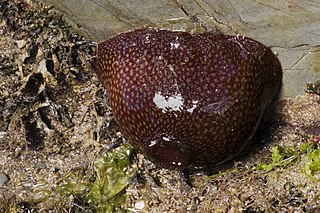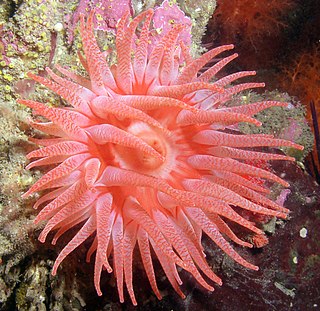
The dahlia anemone is a sea anemone found in the north Atlantic Ocean, the North Sea and the Baltic Sea. Its colour is variable, from deep red to brown or purplish, with green spots and darker tentacles. Dahlia anemones live attached to rock on the seabed from the lower tidal limit down to a depth of 100 m and also attached to other organisms. Their diet comprises small fish and crustaceans, which they immobilize by firing groups of stinging cells (cnidae) into them. Dahlia anemones are closely related to mottled anemones, and both species are usually referred to as northern red anemones.

Actinia fragacea, commonly known as the strawberry anemone, is a species of sea anemone of the order Actiniaria, that occurs from Norway to Africa, including adjacent islands and the Mediterranean. It is generally found on rocks of the lower shoreline and depths up to 8–10 metres (26–33 ft).

Cribrinopsis fernaldi, also known as the crimson anemone, snakelock anemone, chevron-tentacle anemone and Fernald brooding anemone, is a sea anemone native to the Pacific Ocean off northwestern North America.

Urticina crassicornis, commonly known as the mottled anemone, the painted anemone or the Christmas anemone, is a large and common intertidal and subtidal sea anemone. Its habitat includes a large portion of the coastal areas of the northern hemisphere, mainly polar regions, and it lives a solitary life for up to 80 years. Mottled anemones are similar to Dahlia anemones and both are commonly referred to as northern red anemones.

Sea anemones are the marine, predatory animals of the order Actiniaria. They are named after the anemone, a terrestrial flowering plant, because of the colourful appearance of many. Sea anemones are classified in the phylum Cnidaria, class Anthozoa, subclass Hexacorallia. As cnidarians, sea anemones are related to corals, jellyfish, tube-dwelling anemones, and Hydra. Unlike jellyfish, sea anemones do not have a medusa stage in their life cycle.

Epiactis prolifera, the brooding, proliferating or small green anemone, is a species of marine invertebrate in the family Actiniidae. It is found in the north-eastern Pacific. It has a feature rare among animals in that all individuals start life as females but develop testes later in their lives to become hermaphrodites.

Urticina is a genus of relatively large and often colorful sea anemones in the family Actiniidae from the North Pacific, North Atlantic and Arctic Oceans.

Sagartia elegans, the elegant anemone, is a species of sea anemone in the family Sagartiidae. It is found in coastal areas of northwest Europe at depths down to 50 metres.

Urticina eques is a species of sea anemone in the family Actiniidae. It is commonly known as the white-spotted rose anemone or strawberry anemone.

Metridium farcimen is a species of sea anemone in the family Metridiidae. It is commonly known as the giant plumose anemone or white-plumed anemone. It is found in the eastern Pacific Ocean from Alaska down to Catalina Island, California.
Cerianthus lloydii is a species of tube-dwelling sea anemone in the family Cerianthidae. It is sometimes called the lesser cylinder anemone and is found in shallow seas around the coasts of north west Europe.

Bartholomea annulata is a species of sea anemone in the family Aiptasiidae, commonly known as the ringed anemone or corkscrew anemone. It is one of the most common anemones found on reefs in the Caribbean Sea.

Urticina piscivora, common names fish-eating anemone and fish-eating urticina, is a northeast Pacific species of sea anemone in the family Actiniidae.

Anthopleura ballii, commonly known as the red speckled anemone, is a species of sea anemone in the family Actiniidae. It is found in shallow water in the northeastern Atlantic Ocean.

Actinostola callosa is a species of sea anemones in the family Actinostolidae in the order Actiniaria. It is a deep sea species and occurs in both Pacific and Atlantic Oceans from the continental shelf to abyssal depths.

Diadumene leucolena, commonly known as the white anemone or ghost anemone, is a species of sea anemone in the family Diadumenidae. It is an inconspicuous species found in the intertidal and subtidal areas of the northeastern Atlantic Ocean, the Caribbean Sea and the northern Pacific Ocean. Diadumene, "diadem-bearer", referring to the crown of tentacles, is a female form intended to bring to mind the Diadumenos, the renowned Greek sculpture of an athlete crowning himself with the victor's ribbon diadem.

Aulactinia veratra, the green snakelock anemone, is a species of sea anemone in the family Actiniidae. It is native to the southeastern Indian Ocean and the southwestern Pacific Ocean.
Epiactis ritteri, the sandy anemone or Ritter's brooding anemone, is a species of sea anemone in the family Actiniidae. It is found in the Pacific Ocean on the western coast of North America in the shallow sub-littoral zone.
Isotealia antarctica, the salmon anemone, is a species of sea anemone in the family Actiniidae. It is found in the southern Atlantic and Pacific Oceans and the waters around Antarctica. It is a filter feeder and opportunistic predator.

Actinostella flosculifera, the collared sand anemone, is a species of sea anemone in the family Actiniidae. It is found semi-immersed in the sediment in shallow water in the tropical and subtropical Atlantic Ocean.

















